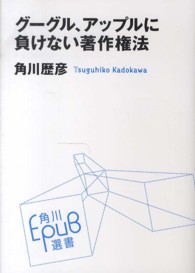- ホーム
- > 洋書
- > 英文書
- > History / World
Full Description
In The Portuguese Slave Trade in Early Modern Japanand Japanese, Chinese, and Korean Slaves, Lucio de Sousa offers a study on the system of traffic of Japanese, Chinese, and Korean slaves from Japan, using the Portuguese mercantile networks; reconstructs the Japanese communities in the Habsburg Empire; and analyses the impact of the Japanese slave trade on the Iberian legislation produced in the 16th and first half of the 17th centuries.
Contents
ContentsAcknowledgmentsList of Figures and TablesList of AbbreviationsIntroductionTerminologyThe Book's Structure1 The Chinese StageThe Chinese StageMacao, Kurofune, and the Slave Trade in Japan: The Earliest EvidenceExamples from the Chinese Diaspora2 The Japanese StageThe Japanese StageThe Iberian Union: The Opening of Private Trade between Macao and Manila and Financial Restructuring in MacaoToyotomi Hideyoshi and the Liberation of Macao Ship Slaves3 The Korean StageThe Macao Ship and Korean SlavesEuropean Missionaries and Traders and the Invasion of Korea by Hideyoshi4 Reorganization of the Portuguese Slave TradeThe End of Korean and Japanese Slavery in the "Nau De Macau" and Its Replacement with Chinese Slavery in the Philippines (1600-14)The Last Chapter of the Portuguese Presence in Japan5 The Structure of Portuguese Slavery in JapanCaptureOther Origins of Japanese Slaves Purchased by the PortugueseSaleTransportationThe Society of Jesus and the Ballot SystemPrice and Number of Slaves6 Case Studies: Crossing DiasporasThe Chinese Slave Victoria Diaz and the Jewish ConversosThe Japanese slave Gaspar Fernandes and the Jewish ConversosThe 1640 Delegation and the "Korean" Miguel CarvalhoFrom Slave of the Society of Jesus to Franciscan Priest: The Case of Jeronimo Iyo ( )/Geronimo de la Cruz7 The Iberian World and the Japanese DiasporaMacaoThe PhilippinesGoaJapanese Mercenaries Serving the Habsburgs in AsiaMexicoPeruArgentinaPortugalSpain8 Japanese Slavery and Iberian LegislationFrom the Reconquista toJapanese Slavery and Iberian Legislation: 1550-80Japanese Slavery and Iberian Legislation: 1580-1600ConclusionBibliographyIndex


















